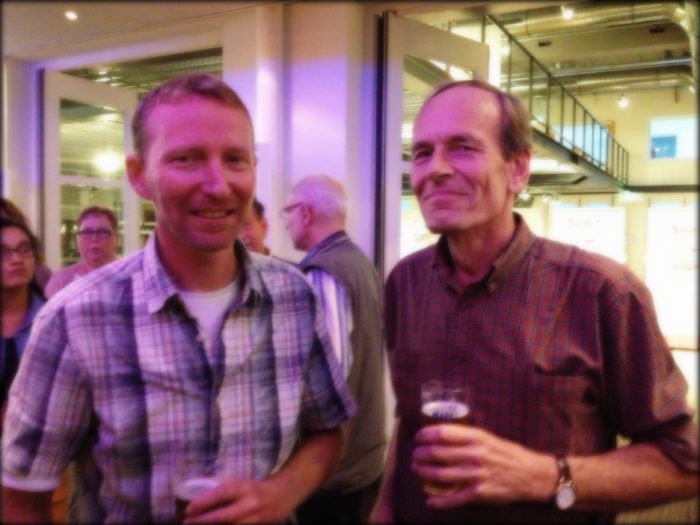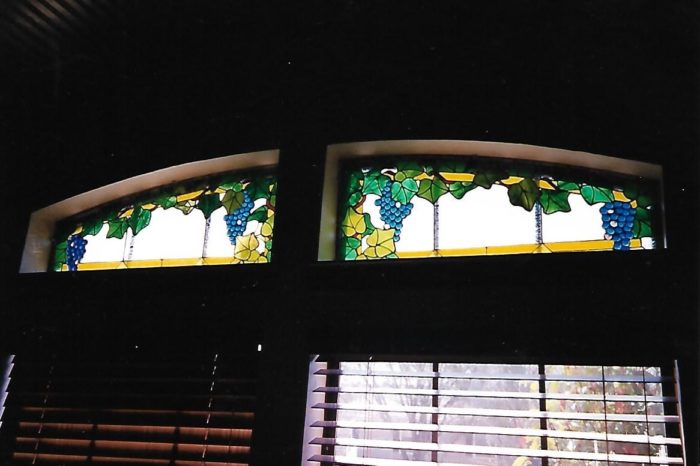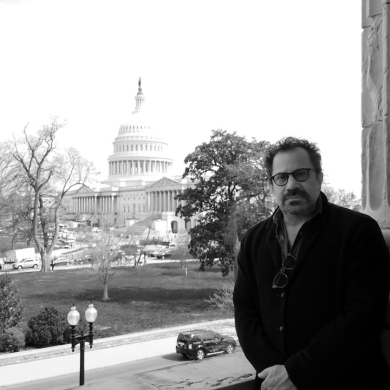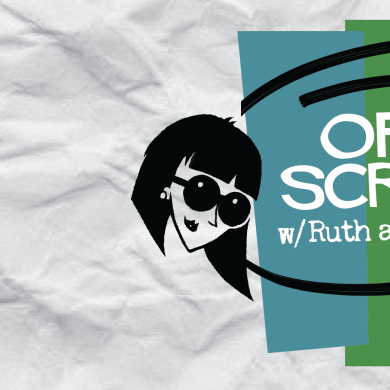By Justin Sanders
With all the deserved flak YouTube has accrued in recent years, it can be easy to forget that a free video platform where anyone can broadcast their talents to the world is not without upside. There are hidden gems from people all across the creative industries who will never, for whatever reason, get the chance to share their gifts through traditional avenues of production and distribution. But on YouTube, they all have an opportunity to express themselves, and they all have the chance to find an audience.
And sometimes, as with musician and glass-maker Tom Simanek, they take that opportunity to venture outside themselves, to make something bigger than their own creative output.

Simanek played the drums growing up, bashing away in the basement of his Wisconsin home. Later, he joined a band, but they never got much farther than some parties, high school dances, and the odd club gig. “People went off to do their own things,” he told CreativeFuture, and Simanek went off to college and earned his degree. He managed institutional and commercial kitchens and restaurants “because it was a living,” and it wound up taking him from California to Texas. Burned out on the restaurant industry, he settled in Dallas, and into a job as a flooring specialist at The Home Depot.
Along the way, Simanek kept making music, writing songs, and singing most of them himself. He dreamt of going professional with it, but a music publisher eluded him, and he had no interest in touring. “Unless you’re a star, traveling in a cramped van and eating crappy food gets old,” he said.
The music kept piling up anyway, an itch that he had to scratch. Most of it was laid down via reel-to-reel tape recording, an audio technology that became largely obsolete with the rise of CDs in the ’90s. Simanek knew he could have his earlier works digitized, but it felt like a lot of work, and he had other interests anyway – like making beautiful custom-glass windows on commission. He assumed the majority of his original music was lost to the sands of time, and he was mostly okay with it.
But then, in the early 2000s, something changed. “I started watching YouTube,” he said, “and I was stunned – by how many great artists were on there, but also by how, at the same time, a lot of it was not so hot. I thought, ‘Hey, wait a minute, I got stuff as good as this.’ That’s when I started pulling up my recordings and posting them.”
Simanek had stacks of audio tapes full of music he had made over the years. “For a long time, I couldn’t even listen to my own music because it was on reels,” he said. With the help of a friend’s reel-to-reel player, he was able to convert the best of the lot to a digital format “that I could use,” he said. And, he was able to start uploading his songs to YouTube.
Still in its infancy, YouTube had yet to be acquired by Google when Simanek first started using it, and it was not yet the overwhelming ocean it would become. The days of receiving 500 hours of new video content every hour were years away, and a talented but unknown musician could still gain a following simply by putting up good songs.
From its inception, Simanek’s YouTube channel, tps607, found a global audience of thousands of listeners who responded to his gentle, yearning lyrics and heartfelt melodies. What’s more, he found himself part of an online community of like-minded musicians excited to connect with each other. New friends invited him to come visit in far-flung locales. He hit it off with a UK-based artist named Rob Elliott, and the two began an Elton John/Bernie Taupin type of collaboration (albeit on a slightly smaller scale), with Simanek writing lyrics and Elliott writing music. To give each song a fresh sound (“I don’t really sing for s**t much anymore,” Simanek said), they began recruiting other YouTubers to sing the songs for them. They created a new channel for these collaborations, EllSimProductions, and what they called “The Singer Series” was born.
“We thought it was such a great deal,” Simanek said. “There are some really fine singers on YouTube, and it was like, ‘Hey, here’s your chance to sing an original song, to make it your own.”
Each singer, once attached to one of their songs, receives lyrics, an instrumental track, and a vocal demo track “that Rob usually sings, so they know kind of what it’s supposed to sound like,” Simanek said. “But we encourage them to play with it. It’s the spontaneous things that sometimes are the coolest.”
Exploring the channels for both Simanek’s solo work and his project with Elliott is like delving into some YouTube alternate universe where the site’s relentless toxicity has been scrubbed and only love and inclusion remain. The hundreds of comments beneath every video are almost universally enthusiastic. The songs themselves are warm and tender. The dozens of different vocal collaborators on display, who range from high school age to senior citizen, sing earnestly, skillfully, and with great feeling.
“Some participants are real ambitious,” Simanek said, providing their own vocal mixes in their recording and even, frequently, shooting their own music video. For other people, he said, “it takes them a while to get their song done, but we never pressure anybody.”
Simanek is not the pressuring type. His own songwriting process is slow and nebulous. He writes a thought down, maybe a line or two, then keeps scribbling away until a complete song emerges from the rubble of paper scraps and jottings. “The hardest part is figuring out where I’m going,” he said. “It takes me a while to get going. I like a challenge. For me, it’s kind of a puzzle.” Working with both his and Elliott’s original music, and with music tracks supplied by other YouTube artists such as Nika Nova, his reputation as a lyricist has grown.
The formation of Simanek’s glass works could also be likened to solving a puzzle. He is careful not to call his craft “stained glass,” and to correct those who do. Stained glass is glass that has been painted then fired in an oven. “I do colored art or ‘leaded’ glass,” Simanek said, which involves drawing a pattern of interlocking shapes, transferring the pattern to pre-colored glass and cutting the shapes out, then soldering the pieces together, joining them with lead came or copper foil.
Simanek got into art glass decades ago, after reading something about Tiffany Studios in New York, renowned for its many and varied types of colored glass developed and produced in the early 1900s. “It intrigued me,” he said. “I was fascinated. I realized that this stuff doesn’t have to just be in the church.”
He took a class from a Dallas-based art glass guru named David Kittrell, who taught him some tricks of the trade. His cutting was slow at first, cautious, but he improved rapidly. “When I decided what the hell I was going to do, I was pretty quick about pursuing it,” he said.
Commissions soon followed. His first paid glass gig was for the arched window over a client’s wine room. It featured a bunch of grapes. Such windows, as well as sidelights, were commonplace in the “little McMansions” that sprouted up all over Dallas during the 1970s and ‘80s, Simanek said. “You couldn’t put a blind on them or a curtain so if you wanted to do something interesting with them, it had to be custom. It was really a good niche for leaded glass, and I did a lot of it.”

Making glass “was never a full-time thing” for Simanek but it was good supplemental income, with clients paying as much as $6,000 for a commission. He tried his hand at craft fairs, too, but found them to be “a losing proposition” because people came “with a flea market mentality,” ready to bargain.
The commissions were his sweet spot but when the recession hit in 2009, a window treatment that cost $150 per square foot was suddenly no longer an option for many people. Fortunately, making glass “wasn’t how I funded my IRA,” he said. As with his music, it was done in the hours between his day job. “I was never particularly rich, but I was able to fund my glass studio,” he said. That was all that mattered.
Simanek retired last year. He spent a good part of the winter in Uruguay and by the time he returned to Dallas, the COVID-19 virus was mounting. “I returned in early February – just in time to not be able to do anything in my retirement but stay home,” he said, chuckling.
In truth, Simanek doesn’t mind staying safe at home. Indeed, he may be in possession of the perfect temperament to wait out a global pandemic. He has his glass studio onsite, a ready supply of paper scraps to scribble on, and he’s very accustomed to communicating and collaborating with friends over the internet.
“I’m still writing stuff down,” he said. “I don’t know where I’ll go with it, but once you start, you really can’t stop. It’s like jogging. You get in the habit of it.”
For those trying to become songwriters themselves – or any kind of writer, for that matter, Simanek suggests “keeping a journal, because you just never know. You’ll see some weird things, whether it’s a bumper sticker or just something out in the world, and if you don’t write it down, the next day, it’s gone.”
For Simanek, a creative life well-lived is its best reward. His creative pursuits may never have become a full-blown livelihood (at least not yet), but, like all of us, he is right where he is supposed to be at this present moment.
“I’ve never been a fine musician, never been a fine singer,” Simanek said (we beg to differ). “But I’ve had a lot of fun and I wrote some pretty good stuff. If you don’t try it, you never know.”
CREATIVITY.INNOVATION.TOMORROW.



